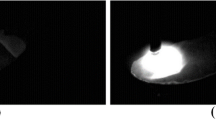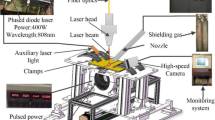Abstract
In keyhole welding, welding quality is closely related to the stability of the keyhole, which is primarily determined by keyhole geometry during the welding process. Three essential attributes to describe the simplified three-dimensional keyhole shape include keyhole size, penetration depth, and keyhole inclination angle. However, when using traditional measurement techniques, it is very challenging to take in-process measurements of penetration depth and inclination angle, even if the keyhole size can be detected by using a visual monitoring system. To realize the on-line estimation of keyhole dynamics and welding defects, a data-based radial basis function neural network state observer is adopted for estimating penetration depth and inclination angle in the transient state when welding parameters change suddenly. First, a static neural network is trained in advance to establish a correlation between the welding parameters and unobservable keyhole geometry. The dynamic state observer is trained based on the transient welding conditions predicted by a numerical model and then used to estimate the time-varying keyhole geometry. Meanwhile, a coaxial monitoring system is used to observe the keyhole shape from the top side in real time, which not only provides input to the neural network but also indicates the potential welding porosities. The predicted results are validated by experimental data obtained by welding of stainless steel 304 and magnesium alloy AZ31B.
Similar content being viewed by others
References
Matsunawa A, Semak V (1997) The simulation of front keyhole wall dynamics during laser welding. J Phys D Appl Phys 30:798–809
Lankalapalli KN, Tu JF, Gartner M (1996) Model for estimating penetration depth of laser welding processes. J Phys D Appl Phys 29:1831–1841
Ronda J, Siwek A (2011) Modelling of laser welding process in the phase of keyhole formation. Arch Civ Mech Eng 113:739–752
Ki H, Mohanty PS, Mazumder J (2002) Modeling of laser keyhole welding: part I. Mathematical modeling, numerical methodology, role of recoil pressure, multiple reflections, and free surface evolution. Metall Mater Trans 33A:1817–1830
Ki H, Mohanty PS, Mazumder J (2002) Modeling of laser keyhole welding: part II. Simulation of keyhole evolution, velocity, temperature profile, and experimental verification. Metall Mater Trans 33A:1831–1842
Pang S, Chen L, Zhou J, Yin Y, Chen T (2011) A three-dimensional sharp interface model for self-consistent keyhole and weld pool dynamics in deep penetration laser welding. J Phys D Appl Phys 44:025301
Zhao H, Niu W, Zhang B, Lei Y, Kodama M, Ishide T (2011) Modelling of keyhole dynamics and porosity formation considering the adaptive keyhole shape and three phase coupling during deep-penetration laser welding. J Phys D Appl Phys 44:485302
Tan W, Bailey NS, Shin YC (2013) Investigation of keyhole plume and molten pool based on a three-dimensional dynamic model with sharp interface formulation. J Phys D Appl Phys 46:055501
Li L (2002) A comparative study of ultrasound emission characteristics in laser processing. Appl Surf Sci 186:604–610
Wang J, Yu H, Qian Y, Yang R (2011) Interference analysis of infrared temperature measurement in hybrid welding. Tarn TJ et al. (Eds.): Robotic welding, intelligence and automation; LNEE 88:369–74
Huang RS, Liu LM, Song G (2007) Infrared temperature measurement and interference analysis of magnesium alloys in hybrid laser-TIG welding process. Mater Sci Eng 447:239–243
Saeed G, Lou M, Zhang YM (2004) Computation of 3D weld pool surface from the slope field and point tracking of laser beams. Meas Sci Technol 15:389–403
Song HS, Zhang YM (2007) Three-dimensional reconstruction of specular surface for a gas tungsten arc weld pool. Meas Sci Technol 18:3751–3767
Kim C, Ah D (2012) Coaxial monitoring of keyhole during Yb:YAG laser welding. Opt Laser Technol 44:1874–1880
Zhang Y, Zhang C, Tan L, Li S (2013) Coaxial monitoring of the fiber laser lap welding of Zn-coated steel sheets using an auxiliary illuminant. Opt Laser Technol 50:167–175
Fabbro R (2010) Melt pool and keyhole behaviour analysis for deep penetration laser welding. J Phys D Appl Phys 43:445501
Fabbro R, Slimani S, Coste F, Briand F (2005) Study of keyhole behavior for full penetration Nd–Yag CW laser welding. J Phys D Appl Phys 38:1881–1887
Fabbro R, Slimani S, Doudet I, Coste F, Briand F (2006) Experimental study of the dynamical coupling between the induced vapor plume and the melt pool for Nd–Yag laser welding. J Phys D Appl Phys 39:394–400
Kawahito Y, Mizutani M, Katayama S (2007) Investigation of high-power fiber laser welding phenomena of stainless steel. Trans JWRI 362:11–16
Wahba M, Katayama S (2012) Laser welding of magnesium alloys. Trans JWRI 411:11–23
Katayama S, Mizutani M, Matsunawa A (2003) Development of porosity prevention procedures during laser welding. Proc SPIE 4831:281–288
Seto N, Katayama S, Matsunawa A (2000) High-speed simultaneous observation of plasma and keyhole behavior during high power CO2 laser welding: effect of shielding gas on porosity formation. J Laser Appl 12:245–250
Kaplan AFH, Mizutani M, Matsunawa A, Katayama S (2002) Unbounded keyhole collapse and bubble formation during pulsed laser interaction with liquid zinc. J Phys D Appl Phys 35:1218–1228
Elanayar S, Shin YC (1994) Radial basis function neural network for approximation and estimation of nonlinear stochastic dynamic systems. IEEE Trans Neural Netw 54:594–603
Elanayar S, Shin YC (1995) Robust tool wear estimation with radial basis function neural networks. Trans. of the ASME, J Dyn Control Syst 117:459–67
Lee CW, Shin YC (2003) Construction of fuzzy systems using least-squares method and genetic algorithm. Fuzzy Sets Syst 137:297–323
Author information
Authors and Affiliations
Corresponding author
Rights and permissions
About this article
Cite this article
Luo, M., Shin, Y.C. Estimation of keyhole geometry and prediction of welding defects during laser welding based on a vision system and a radial basis function neural network. Int J Adv Manuf Technol 81, 263–276 (2015). https://doi.org/10.1007/s00170-015-7079-1
Received:
Accepted:
Published:
Issue Date:
DOI: https://doi.org/10.1007/s00170-015-7079-1




